

The Village Area of Bartlett
Page 2
Fred and Grace Garland operated Garland's Tea Room, and later it was a restaurant and ice cream parlor know simply as "Garlands". It also had a few cabins, some of which are still there today. This restaurant operated until the early 1970's and was destroyed by fire. It was located just west of today's Post Office.
In the 1948 picture below today's Post Office would be behind the Garlands Cabins sign.

The What Not Shop was operated by Franklin and Almeda George from the mid 1940's. True to it's name, the store carried practically everything one could want in those days and even had an ice cream soda parlor and a barber shop. For quite a time he also sold gasoline out front. Franklin was the Town tax collector in those days and he operated that activity from the store as well. Franklin and his wife lived right across the street in the same house that his ancestors operated as an Inn in the mid 1800's. After Franklin's death the store was operated by Dottie Howard for a few years and then by David & Debby Phanauef, who renamed it to the Bear Notch Deli. David later sold the store to The Ryans. In January of 2009 the store was completely destroyed by fire caused by an electrical problem.
This photo of the What Not Shop is from the mid 1950's. Today (2024) this site is a parking lot for the church.
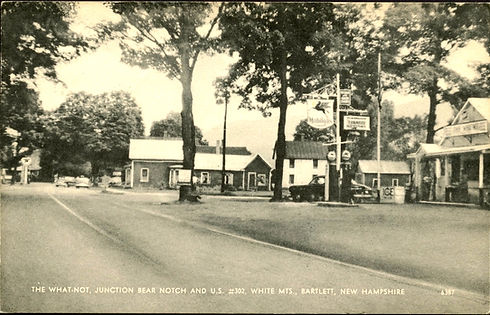
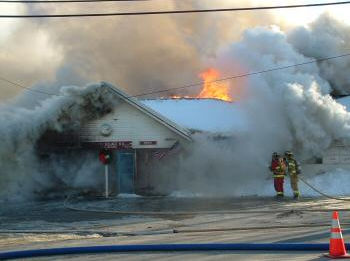
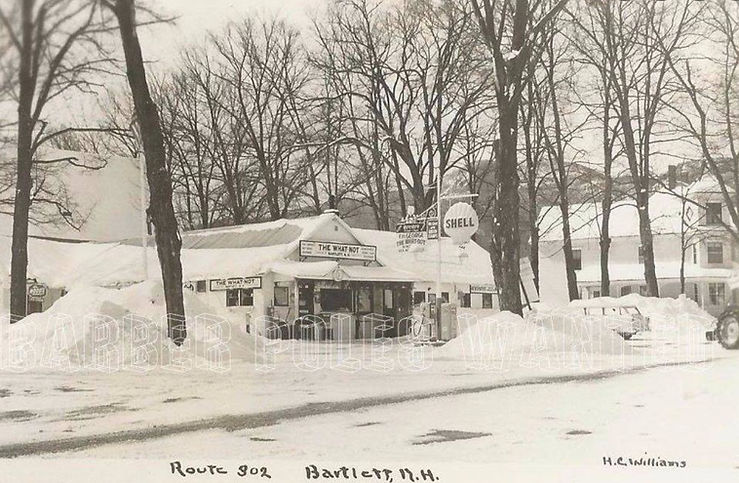
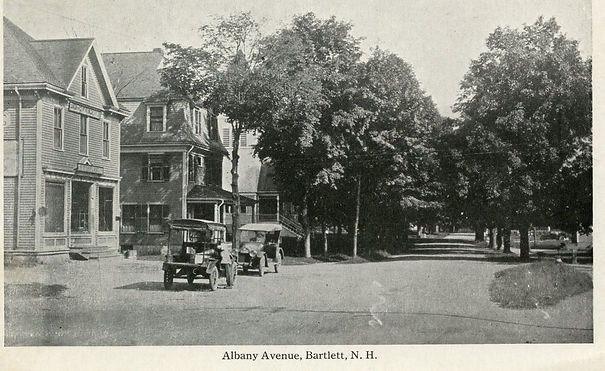
1907: Bartlett Village Railroad Square: The big white building is the Odd Fellows Hall, which has a stage and movie theatre. Next door to that is Hellen Hayes lodging house, The Maplewood.
Hellen also operated The Elmcrest during the 1930's. That building is still standing and is located almost opposite the present day Villager Motel, It has been vacant for years. I recall watching Carroll Hayes butcher cattle in the barn there in the 1960's.
Hellen, being an ambitious person also operated a restaurant, The Red Rooster, located on Main Street where Lydia Lansing now lives (2020).
The brown building (above) on Albany Avenue was a grocery store operated by the Gosselins, Joe and Myrtle and their two kids David and Sue. Mr Ryle ran a kindergarten upstairs. Mr. Wimpy Thurston Purchased the business from the Gosselins. Wimpy was one of the first real estate brokers in the area and by the mid 1950's he sold the store to Harold and Edith Jacobson and their son Arthur. Wimpy found real estate a better calling than storekeeper and he moved to North Conway and opened his office there at the Junction of Rte 16 and 302 next door to what was then The Yield House. The Jacobsons' were the last to operate a business here, which they continued well into the 1970's.
After the Jacobson's sold the property it sat vacant for a time during which a zoning ordinance was enacted that made this area residential. A business no longer permitted, the building sat vacant until the Hodgkins family next door purchased it and the building was razed in the late 1990's. The land is still owned by the Hodgkins, who live next door.
Next to the store is The Garland, an Inn built by Eben Garland. It also housed a drug store and jewelry store. It was sold to the Hodgkins family about 1920 for use as a private residence. It is still owned by the Hodgkins family. (photo above, right)
The top picture was taken from the vicinity of the Railroad Depot building, Rail tracks are just to the left of this picture.
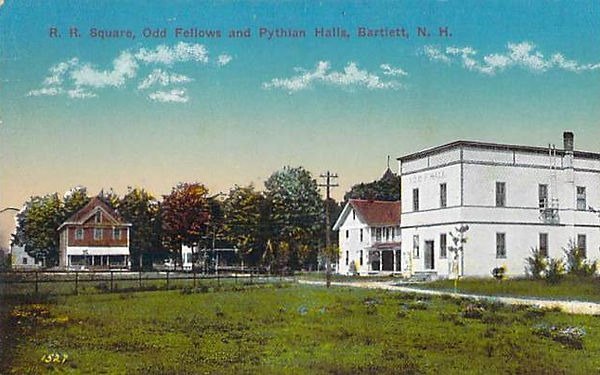

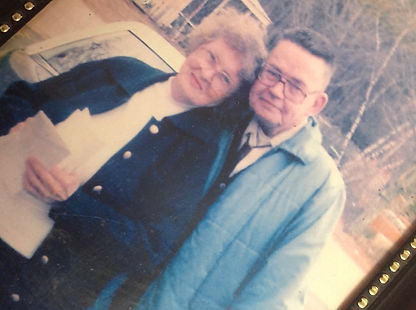
Edith and Harold Jacobson - undated photo
Arthur Jacobson, 2012
Obituary HERE
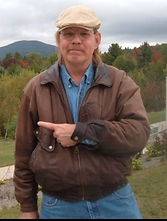
The Helen Hayes House where she operated the Maplewood Inn and raised her children and grandchildren.
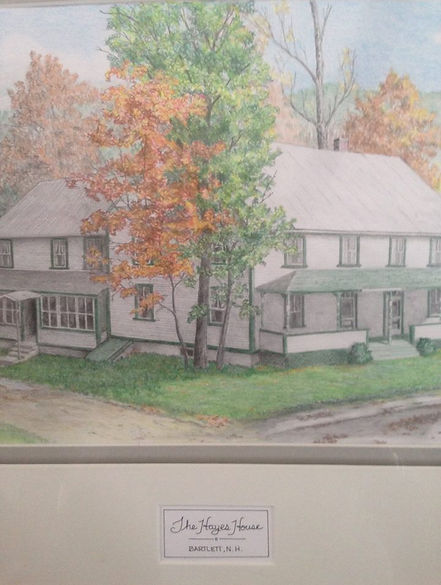

The Union Congregational Church on Albany Ave dated 1906, above and St Joseph's Catholic Church located on School Street, probably 1950's.


Bartlett Lumber Company and Kearsarge Peg Mill complex about 1900
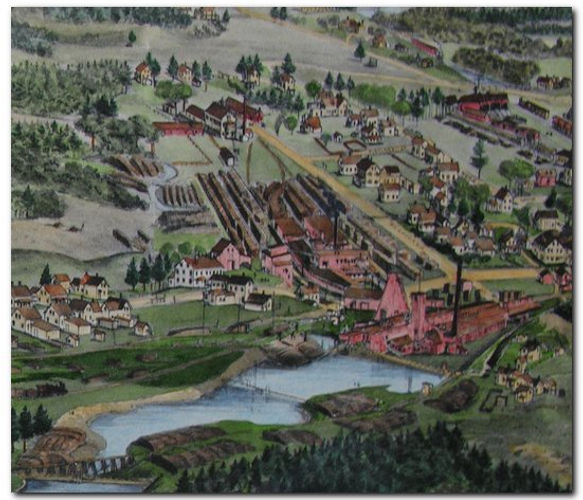
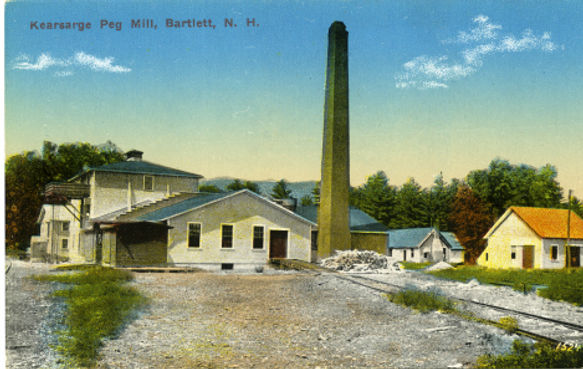
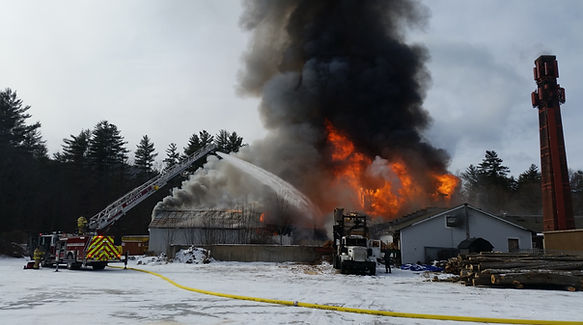
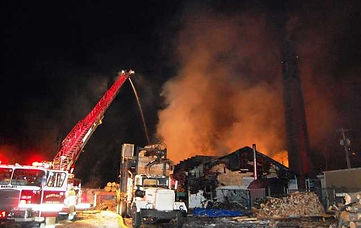
FEB 12, 2016-BARTLETT — No one was injured but one of the world’s most unusual manufacturers and a major part of the town’s history was destroyed Friday afternoon when a fire leveled the Kearsarge Peg Company. Bartlett Fire Chief Pat Roberts, who said the fire was reported around 1:11 p.m. Friday by a custodian from the nearby Josiah Bartlett Elementary School, called the mill a total loss.
Three people were inside the structure at the time of the fire and they managed to exit safely. Roberts said firefighters from between Tamworth and Jackson responded to the scene, adding that water and weather were both challenges. The first, he said, had to be drafted from the Saco River and then shuttled, while the second was down-right cold, with temperatures in the low double digits that froze firefighters and water alike. While the cause and origin of the fire remain under investigation, Roberts was clear that the fire is “absolutely not” suspicious.
Gene Chandler, who chairs the Bartlett Board of Selectmen and is also a state representative, called the destruction of the mill “a terrible loss for the history of the Town of Bartlett,” recalling how the mill had at one time been one of the town’s largest employers and also a supplier of saw dust to farms, like the Chandler’s.
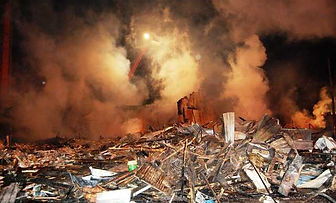
Kearsarge Peg Co., Inc. was a business located in Bartlett, NH that had been in continuous operation in this location for 121 years until it was destroyed by fire in February 2016. The company prospered through the years on its reputation for quality products and timely delivery. The original product (hardwood shoe pegs and hardwood tumbling media) is still manufactured in the facility, and in fact, Kearsarge was the only manufacturer of this product in North America.
The principal business of the company at its inception was the manufacture of shoe pegs. Shoe pegs were long cross sectioned hardwood shapes with a point on one end, manufactured primarily from white, yellow and silver birch, although white maple and beech are occasionally employed as well. The Kearsarge Peg Co. manufactured approximately seventy-five different sizes of shoe pegs, which varied in size from 5/16 in. long by 1/18 in. wide to ¼ in. wide by 2.0 in. long . This product was used as a component of shoe manufacturing in the nineteenth and early twentieth century, and replaced shoe nails, as a means for insuring a lasting bond between the last and sole of the shoe. It was considered superior to metal nails, in that over time the wood peg would draw moisture from the ambient atmosphere and swell, forming a lock fit between these two components. Shoe manufacturing along with textiles was a major segment of the economy of New England at this time, and there were dozens of plants, which made this product in competition with Kearsarge. In its earlier years, Kearsarge exported heavily to the shoe industry in Norway, Germany, Australia and elsewhere.
The use of pegs in shoe manufacturing came to an abrupt halt with the advent of the Second World War. (Exception: custom made climbing, skiing and cowboy boots). Not only did the company find that its export markets were now closed, but new developments in shoe manufacturing technology obviated the need for pegs to tie or lock the last and sole of shoes together. Lupoline, under the director of its founder Joseph Lupo of pioneered dry barrel finish or tumbling techniques in the early part of the twentieth century, with some patents dating as early as the 1920’s and 1930’s. He found that “shoe pegs” made an ideal mass finishing media for smoothing and polishing plastic parts in rotary barrel finish equipment. This technology was quickly adapted by major manufacturers such as Bausch & Lomb, Foster-Grant and the American Optical Co. and others to replace tedious manual finishing methods that involved buffing. These large manufacturers of eyeglass frame and sunglass frame components were soon utilizing hardwood pegs in bulk, by the truck load and even car load for abrasive finishing and polishing operations. This continues to be the primary use for hardwood pegs and other hardwood preform shapes that the company manufactures to this day. In the early 1980’s the company management decided that there was a need to become more involved on a technical level with the finishing industry. As a result the PEGCO Division was instituted as a marketing and technical arm to more aggressively market hardwood media for other applications. It soon became apparent that there was a need to make PEGCO a technical resource for the finishing industry. Its focus became providing technical solutions to difficult edge and surface finish problems by process development in its “process laboratory” and offering turn-key equipment and abrasive supply packages as the solutions to these problems. The company’s office and manufacturing facilities are found at the same location in Bartlett, NH. These facilities are comprised of approximately 25,000 square feet of manufacturing and warehouse space encompassed in an eleven building complex, situated on seven acres bounded by Kearsarge Street and the White Mountain National Forest.

1949 Photo: Standing, Lillian Sanborn, Leon Sanborn, ??? - Seated, Ray Abbott and not sure who child might be.
![abbottSanbornChadbourne1949Photo [1].jpg](https://static.wixstatic.com/media/fa72d9_8eb0740b932f4695a0f8b51400451f21~mv2.jpg/v1/fill/w_600,h_843,al_c,q_85,usm_0.66_1.00_0.01,enc_avif,quality_auto/abbottSanbornChadbourne1949Photo%20%5B1%5D.jpg)
